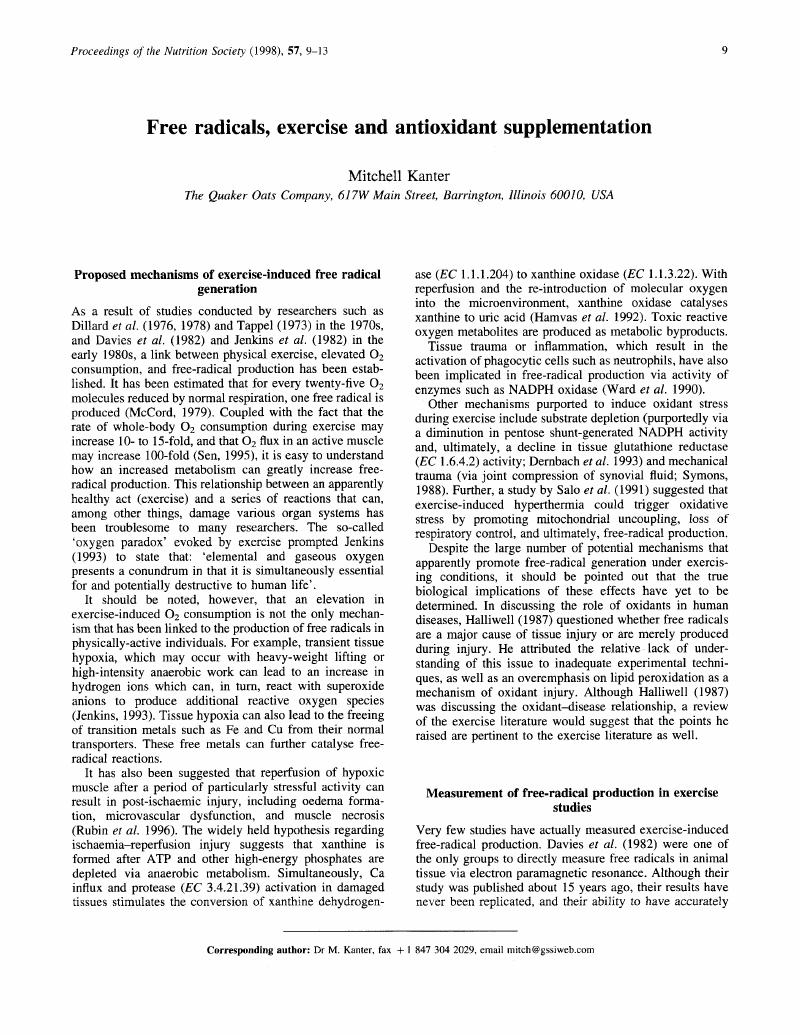Crossref Citations
This article has been cited by the following publications. This list is generated based on data provided by Crossref.
Whitley, Helena A.
Humphreys, S. M.
Campbell, I. T.
Keegan, M. A.
Jayanetti, T. D.
Sperry, D. A.
MacLaren, D. P.
Reilly, T.
and
Frayn, K. N.
1998.
Metabolic and performance responses during endurance exercise after high-fat and high-carbohydrate meals.
Journal of Applied Physiology,
Vol. 85,
Issue. 2,
p.
418.
Poulsen, Henrik E.
Weimann, Allan
and
Loft, Steffen
1999.
Methods to detect DNA damage by free radicals: relation to exercise.
Proceedings of the Nutrition Society,
Vol. 58,
Issue. 4,
p.
1007.
Scheett, Timothy P
Mills, Paul J
Ziegler, Mike G
Stoppani, James
and
Cooper, Dan M
1999.
Effect of Exercise on Cytokines and Growth Mediators in Prepubertal Children.
Pediatric Research,
Vol. 46,
Issue. 4,
p.
429.
Ripley, Melissa
Klimis-Zacas, Dorothy
Wolinsky, Ira
and
Taylor, Paul
2000.
Nutritional Applications in Exercise and Sport.
Vol. 20003946,
Issue. ,
p.
81.
Clarkson, Priscilla M
and
Thompson, Heather S
2000.
Antioxidants: what role do they play in physical activity and health?.
The American Journal of Clinical Nutrition,
Vol. 72,
Issue. 2,
p.
637S.
Reid, Michael B.
2001.
Invited Review: Redox modulation of skeletal muscle contraction: what we know and what we don't.
Journal of Applied Physiology,
Vol. 90,
Issue. 2,
p.
724.
Aessopos, Athanasios
Tsironi, Maria
Vassiliadis, Ioannis
Farmakis, Dimitrios
Fountos, Alexandros
Voskaridou, Ersi
Perakis, Alexandros
Defteraios, Spyros
Loutradi, Aphrodite
and
Loukopoulos, Dimitrios
2001.
Exercise-induced myocardial perfusion abnormalities in sickle β-thalassemia: Tc-99m tetrofosmin gated SPECT imaging study.
The American Journal of Medicine,
Vol. 111,
Issue. 5,
p.
355.
Dufresne, Christiane J.
and
Farnworth, Edward R.
2001.
A review of latest research findings on the health promotion properties of tea.
The Journal of Nutritional Biochemistry,
Vol. 12,
Issue. 7,
p.
404.
Evelson, P.
Gambino, G.
Travacio, M.
Jaita, G.
Verona, J.
Maroncelli, C.
Wikinski, R.
Llesuy, S.
and
Brites, F.
2002.
Higher antioxidant defences in plasma and low density lipoproteins from rugby players.
European Journal of Clinical Investigation,
Vol. 32,
Issue. 11,
p.
818.
Toyosaki, Toshiyuki
2002.
Antioxidant effect ofβ-carotene on lipid peroxidation and synergism with tocopherol in an emulsified linoleic acid model system.
International Journal of Food Sciences and Nutrition,
Vol. 53,
Issue. 5,
p.
419.
Anderson, Richard A.
2002.
Trace Elements in Man and Animals 10.
p.
393.
Bouchard, Ron
Weber, Anna R.
and
Geiger, Jonathan D.
2002.
Informed Decision-Making on Sympathomimetic Use in Sport and Health.
Clinical Journal of Sport Medicine,
Vol. 12,
Issue. 4,
p.
209.
Deaton, Christopher M.
and
Marlin, David J.
2003.
Exercise-associated oxidative stress.
Clinical Techniques in Equine Practice,
Vol. 2,
Issue. 3,
p.
278.
2004.
Handbook of Minerals as Nutritional Supplements.
Vol. 20043985,
Issue. ,
Neville, R. F.
Hollands, T.
Collins, S. N.
and
Keyte, F. V.
2004.
Evaluation of urinary TBARS in normal and chronic laminitic ponies.
Equine Veterinary Journal,
Vol. 36,
Issue. 3,
p.
292.
Orhan, Hilmi
van Holland, Berry
Krab, Betty
Moeken, Janine
Vermeulen, Nico P.E.
Hollander, Peter
and
Meerman, John H.N.
2004.
Evaluation of a Multi-parameter Biomarker Set for Oxidative Damage in Man: Increased Urinary Excretion of Lipid, Protein and DNA Oxidation Products after One Hour of Exercise.
Free Radical Research,
Vol. 38,
Issue. 12,
p.
1269.
Thomson, C D
2004.
Assessment of requirements for selenium and adequacy of selenium status: a review.
European Journal of Clinical Nutrition,
Vol. 58,
Issue. 3,
p.
391.
Vollaard, Niels B J
Shearman, Jerry P
and
Cooper, Chris E
2005.
Exercise-Induced Oxidative Stress.
Sports Medicine,
Vol. 35,
Issue. 12,
p.
1045.
HO, Siu P.
CHAN‐YEUNG, Moira
CHOW, Kathy K.M.
IP, Mary S.M.
and
MAK, Judith C.W.
2005.
Antioxidant enzyme activities in healthy Chinese adults: influence of age, gender and smoking*.
Respirology,
Vol. 10,
Issue. 3,
p.
305.
Davison, Gareth W.
Morgan, Rhian M.
Hiscock, Natalie
Garcia, Juan M.
Grace, Fergal
Boisseau, Natalie
Davies, Bruce
Castell, Linda
McEneny, Jane
Young, Ian S.
Hullin, David
Ashton, Tony
and
Bailey, Damian M.
2006.
Manipulation of systemic oxygen flux by acute exercise and normobaric hypoxia: implications for reactive oxygen species generation.
Clinical Science,
Vol. 110,
Issue. 1,
p.
133.



